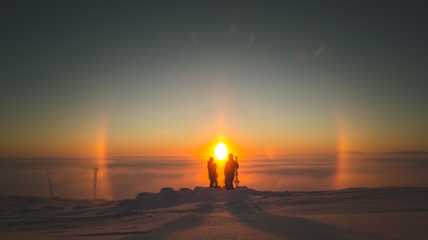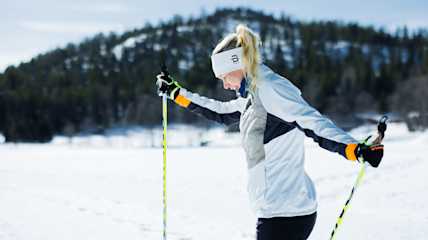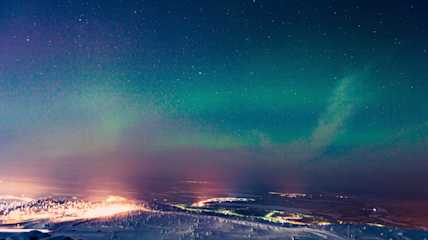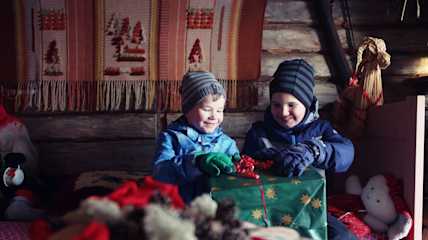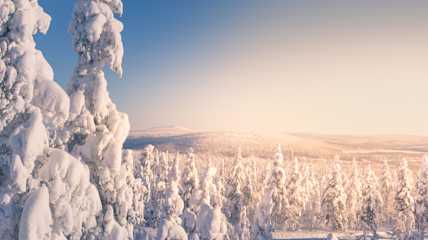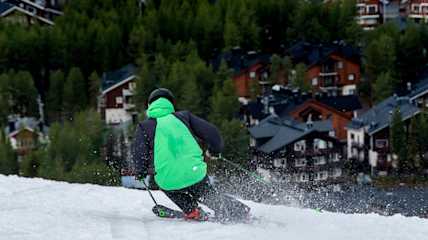
Birds of Lapland – 11 Fascinating Species near Levi
Levi is known for its fells, ski slopes, and northern lights – but did you know it also offers a captivating world for birdwatchers?
Just a stone’s throw from Levi, you can spot species like the Siberian Jay and Bluethroat, or hear the Boreal Owl calling in the quiet of the night. This guide introduces 11 bird species that can be observed in Levi’s forests, wetlands, fells, and lakeshores. It includes location tips, sound samples, and image links – everything you need to discover a whole new way to experience Levi.
Friends of the Coniferous Forests
🧡 Siberian Jay (Perisoreus infaustus)
A legendary bird in many tales of Lapland and a mythical inhabitant of old forests. It’s a birdwatcher’s dream – not only for its looks but also for its sociable nature. This friendly bird is known for its boldness and curiosity.
Where to find it: Old spruce forests, such as around Pyhätunturi and the foothills of Kätkätunturi. Nests in tree branches.
Appearance: Medium-sized, reddish-brown tones, orange tail
Sound: Soft, quiet “tsärr” – Listen to the Siberian Jay and view image
Special: A bold and sociable companion of wilderness wanderers – it might even snatch a snack from your campfire stop. According to old beliefs, spotting a Siberian Jay brings luck to hunters.
🖤 Raven (Corvus corax)
An intelligent guardian of the wild, soaring above with a rough, echoing call. Often seen alone or in pairs. Its strong and easily recognizable voice adds mystique to the silence above the forests and fells.
Where to find it: Wilderness areas and forest edges around Levi – good chance of observation in many locations. Nests on high cliffs or secluded trees.
Appearance: Large, glossy black, strong beak, long tail
Sound: Low, rough ��“krok-kraa” – Listen to the Raven and view image
Special: A symbolic and long-lived bird of ancient beliefs. One of the most intelligent birds in the world – even known to use tools. In Finland most common in Lapland.
🌙 Boreal Owl (Aegolius funereus)
The mysterious musician of Lapland’s silent spruce forests. Its haunting call in spring evenings and nights sharpens your senses and enchants the forest. This shy bird is most easily detected by ear.
Where to find it: Old spruce and mixed forests – for example, areas north of Lake Immeljärvi and Fell Kätkätunturi’s woods. Often nests in old woodpecker holes or nest boxes.
Appearance: Small, round-headed owl with yellowish-brown coloring and white spots
Sound: Regular, flute-like “pu-pu-pu…” – Listen to the Boreal Owl and view image
Special: Although one of Finland’s most common owls, it is rarely seen. Mating calls begin as early as March and create unforgettable experiences for hikers.
Resilient Survivors of the North
❄️ Willow Ptarmigan (Lagopus lagopus)
A true master of survival in Arctic conditions and a camouflage expert, blending into the landscape with seasonal plumage changes. In winter, it hides in snow burrows; in summer, it stays low in shrubs.
Where to find it: Wooded areas, bog edges, mountain birch zones – occasionally seen on Levi Fell. Nests on the ground in shrubs or sheltered slopes.
Appearance: Completely white in winter with a black eye stripe and beak; mottled brown-gray-black in summer (females more so), males darker with some white on wings and legs
Sound: Does not sing, makes clucking sounds especially in spring – Listen to the Willow Ptarmigan and view image
Special: Its playful clucks break the Arctic silence and can startle hikers. As a master of disguise, it often flushes from underfoot at the last second.
🤍 Snow Bunting (Plectrophenax nivalis)
A cheerful sign of spring in the fells – a small bird in white and brown tones, singing brightly in rocky highlands even while snow still lingers.
Where to find it: Open fell slopes and rocky outcrops – upper parts of Levi and Kätkätunturi. Nests hidden among rocks – hard to detect.
Appearance: Pale bird with dark wing markings, nearly white in winter
Sound: High-pitched “pli-pli” chirping – Listen to the Snow Bunting and view image
Special: The only passerine bird that nests exclusively in Fell Lapland. Symbolizes the beauty and resilience of the harsh North. In late winter, flocks can be seen foraging on bare slopes.
🌲Siberian Tit (Poecile cinctus)
A humble northern bird that endures the harsh Lapland winters year-round. Its gentle chirping offers a quiet reminder of nature’s resilience.
Where to find it: Coniferous forests, such as around Lake Immel and Kätkätunturi. Nests in tree cavities or nest boxes.
Appearance: Brownish-gray back, black throat, pale belly
Sound: Soft trills and clicking – Listen to the Siberian Tit and view image
Special: A permanent northern resident, nesting early in the season. A true survivor that brings life to the forest even in the heart of winter.
Beauties of Wetlands and Waters
🦆 Eurasian Teal (Anas crecca)
A small, lively duck and agile diver that brightens Levi’s wetlands in spring and summer. The male’s metallic green eye-stripe and cheerful calls make it the gem of springtime wetlands.
Where to find it: Akanrimpi bird tower, wetlands around Lake Levi. Nests in low vegetation near water.
Appearance: Male gray-brown with a shiny green eye-stripe; female mottled brown
Sound: Male makes high, snapping whistles “krik-krik” – Listen to the Eurasian Teal and view image
Special: Finland’s smallest duck species. Arrives early with spring meltwaters and disappears quietly by late summer.
💧Goldeneye (Bucephala clangula)
A graceful and elegant diver, perfectly adapted to aquatic life. Prefers calm lakes and ponds. The male is easy to spot with its black-and-white plumage and iridescent green head.
Where to find it: Lakes and ponds. Nests in tree holes or nest boxes near water.
Appearance: Male black and white, female brown-headed
Sound: Metallic “kliin-kliin,” wings whistle when flying – Listen to the Goldeneye and view image
Special: Its whistling wings often announce its presence before it’s seen. Look for nest boxes along shorelines to locate observation spots.
🧭 Arctic Tern (Sterna paradisaea)
A graceful spring arrival and aerial acrobat, easily identified by its agile flight and sharp calls. This true world traveler adds summer liveliness to wetlands, lakeshores, and riverbanks.
Where to find it: Akanrimpi, shores of Lakes Levi and Immel, flood meadows of nearby rivers. Nests on gravel banks and rocky shores.
Appearance: White, sleek body, pointed wings, black cap, long tail
Sound: Bright, sharp “krii-ää” – Listen to the Arctic Tern and view image
Special: Makes the world’s longest annual migration – up to 70,000 km per year! Breeds in Lapland during summer, winters in Antarctica.
Singers of Birch Forests and Stream Banks
🌳 Brambling (Fringilla montifringilla)
The melodic companion of Lapland’s birch forests, its metallic song rings out even when the bird stays hidden in the canopy. Colorful and vibrant – like spring itself. Resembles the chaffinch but with an orange breast and white wings.
Where to find it: Birch forests, Ounasjoki river valleys. Nests on tree branches, often birch.
Appearance: Male with orange breast, black crown, white wing stripe
Sound: Metallic “zräh-zräh” – Listen to the Brambling and view image
Special: Many recognize its song, few know its looks. Often heard in spring, but takes a sharp eye to spot.
💙 Bluethroat (Luscinia svecica)
The jewel of Lapland’s early summer. This small, bright bird sings a clear and chatty melody from willow thickets and mountain birch groves. Its song is one of the most stirring sounds of Levi’s wilderness.
Where to find it: Willow thickets along streams and in mountain birch areas – excellent spotting from Akanrimpi bird tower. Nests low in bushes.
Appearance: Small flycatcher-like bird; males have a bright blue throat often with a red or orange spot
Sound: Versatile, bright song, often mimics other birds – Listen to the Bluethroat ans view image
Special: The provincial bird of Lapland and nicknamed “the nightingale of the North.” Hard to spot but hard to miss once it sings – stop and watch the brush closely when you hear it.
📍Where to Go Birdwatching Near Levi?
Akanrimpi Bird Tower (approx. 7 km from Levi towards Köngäs): Excellent for spotting Bluethroats, Arctic Terns, Teals, and Goldeneyes. Bonus: beautiful views of Levi and Kätkätunturi.
Fell Kätkätunturi Trails: Good chance of seeing Siberian Jays, Snow Buntings, and hearing Boreal Owls at night.
Wetlands near Köngäs village and Ounasjoki river birch groves: Habitat for Willow Ptarmigans and Bramblings.
Wetlands of Lake Levijärvi: Great for observing waterbirds and Arctic Terns.
Forests around Lake Immeljärvi: Home to the Siberian Tit and Boreal Owl.
🔍 Birdwatching Tips
Bring binoculars! Scan fells, bogs, forests, and waterways – even a flicker at the edge of your vision can be a clue.
Listen, don’t just look. Recognizing bird sounds adds a whole new dimension to your outing. Use apps like Merlin to help identify them.
Go early or late. Birds are most active at sunrise. Evenings are also great for spotting or hearing birds.
Pack water and snacks. Good birding spots often require a short hike. Make your excursion longer for both body and mind.
Combine activities. Hiking, biking, and paddling are excellent ways to enjoy birds while exploring Levi’s trails and waters.
Respect nature. Stay on trails. Avoid disturbing nesting areas or getting too close to any animals.
Ready for a True Local Nature Adventure? Birdwatching requires no experience – just time, curiosity, and an open mind. Levi’s incredible nature is full of silent sightings, songs, wingbeats, and surprises.
